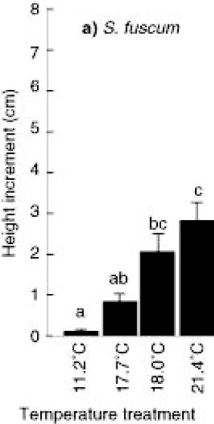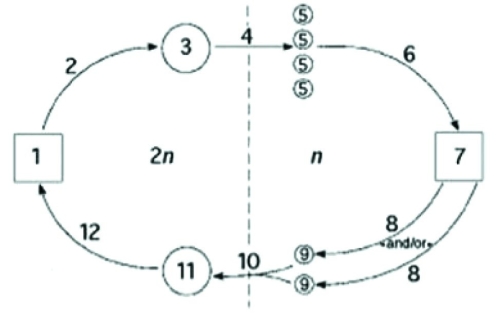A) the gametophyte generation produces spores
B) the sporophyte generation produces pollen
C) the sporophyte generation produces spores
D) the gametophyte generation produces pollen
Correct Answer

verified
Correct Answer
verified
Multiple Choice
Which of the following is a similarity between bryophytes and seedless vascular plants?
A) Plants in both groups have vascular tissue.
B) In both groups, sperm swim from antheridia to archegonia.
C) The dominant generation in both groups is the sporophyte.
D) Plants in both groups have true roots, stems, and leaves.
Correct Answer

verified
Correct Answer
verified
Multiple Choice
In an investigation of Sphagnum growth, researchers measured the growth of four different S. fuscum species (labeled a, ab, bc, and c in the figure) at four temperatures. The results of the investigation are represented in the graph.  Which of the following claims is most consistent with the data?
Which of the following claims is most consistent with the data?
A) S. fuscum species are best adapted to live in warm climates.
B) S. fuscum species grow faster at moderate temperatures.
C) S. fuscum species grow slower at warmer temperatures.
D) S. fuscum species are best adapted to growth in cold climates.
Correct Answer

verified
Correct Answer
verified
Multiple Choice
Which of the following features of fertilization in plants are the same as in some of their algal ancestors?
A) Conjugation tubes are formed between sperm and egg cells.
B) Packets of sperm are delivered by wind to the eggs.
C) Aquatic invertebrates carry sperm to eggs.
D) Flagellated sperm swim to the eggs in a water drop.
Correct Answer

verified
Correct Answer
verified
Multiple Choice
Which of the following organisms were most likely the direct ancestors of plants?
A) kelp (brown alga) that formed large beds near the shorelines
B) green algae
C) photosynthesizing prokaryotes (cyanobacteria)
D) liverworts and mosses
Correct Answer

verified
Correct Answer
verified
Multiple Choice
Use the following information to answer the question. Big Bend National Park in Texas is mostly Chihuahuan desert, where rainfall averages about 25 centimeters per year. Yet, it is not uncommon when hiking in this extremely arid zone to encounter mosses and ferns. One such plant is called "flower of stone." It is not a flowering plant, nor does it produce seeds. Under arid conditions, its leaflike structures curl up. However, when it rains, it unfurls its leaves, which form a bright green rosette on the desert floor. Consequently, it is sometimes called the "resurrection plant." At first glance, it could be a fern, a true moss, or a spike moss. Upon closer inspection of the leaves of "flower of stone," one can observe tiny, cone-like structures. Each cone-like structure emits spores of two different sizes. Further investigation also reveals that the roots of "flower of stone" branch only at the growing tip of the root, forming a Y-shaped structure. Consequently, "flower of stone" should be expected to possess which other characteristics?
A) a gametophyte generation that is dominant and lignified vascular tissues
B) a gametophyte generation that is dominant and spores that are diploid when mature
C) lignified vascular tissues and microphylls
D) microphylls, filamentous rhizoids, but not true roots, and spores that are diploid when mature
Correct Answer

verified
Correct Answer
verified
Multiple Choice
Which taxon includes organisms referred to as "embryophytes"?
A) Plantae
B) Pterophyta
C) Bryophyta
D) Charophycea
Correct Answer

verified
Correct Answer
verified
Multiple Choice
Three of the following are evidence that charophytes are the closest algal relatives of plants. Select the exception.
A) similar sperm structure
B) the presence of chloroplasts
C) similarities in cell wall formation during cell division
D) genetic similarities in chloroplasts
Correct Answer

verified
Correct Answer
verified
Multiple Choice
Assuming equal spore production rates, what is a likely consequence in a bryophyte with both asexual and sexual reproduction versus one with only sexual reproduction?
A) Species with both types of reproduction have higher rates of genetic diversity than species with only sexual reproduction.
B) Species with both types of reproduction have higher population growth rates than species with only sexual reproduction.
C) Species with both types of reproduction are less evolutionarily advanced than species with only sexual reproduction.
D) Species with both types of reproduction occur primarily in dry environments.
Correct Answer

verified
Correct Answer
verified
Multiple Choice
Suppose an efficient conducting system evolved in a moss that could transport water and other materials as high as a tall tree. Which of the following statements about "trees" of such a species would be true?
A) spore dispersal distances would probably decrease
B) females could produce only one archegonium
C) unless its body parts were strengthened, such a "tree" would probably flop over
D) individuals would probably compete less effectively for access to light
Correct Answer

verified
Correct Answer
verified
Multiple Choice
Which of the following characteristics is found in heterosporous plants?
A) two types of sporophylls
B) vascular tissue
C) one type of sporophyll
D) a diploid sporophyte produces spores via meiosis
Correct Answer

verified
Correct Answer
verified
Multiple Choice
Use the following description to answer the question. A biology student hiking in a forest discovers an erect, 15-centimeter-tall plant that bears microphylls and a strobili at its tallest point. When disturbed, the cone emits a dense cloud of brownish dust. Observing a sample with a magnifying glass reveals the dust to be composed of tiny spheres with a high oil content. What type of plant has this student most likely discovered?
A) bryophyte sporophyte
B) fern sporophyte
C) horsetail gametophyte
D) lycophyte sporophyte
Correct Answer

verified
Correct Answer
verified
Multiple Choice
Which of the following structures is present in a bryophyte at some point in their life cycles?
A) microphylls
B) true roots
C) true leaves
D) sporangia
Correct Answer

verified
Correct Answer
verified
Multiple Choice
A botanist discovers a new species of plant in a tropical rain forest. Investigation of its anatomy and life cycle shows the following characteristics: flagellated sperm, xylem with tracheids, separate gametophyte, sporophyte generations with the sporophyte dominant, and no seeds. To which of the following groups does this plant most likely belong?
A) mosses
B) ferns
C) gymnosperms
D) flowering plants
Correct Answer

verified
Correct Answer
verified
Multiple Choice
The observation that both charophytes and green plants contain chlorophylls a and b is more consistent with which of the following claims?
A) These derived traits show that green plants evolved from ancient charophytes.
B) These shared traits show that green plants evolved from present-day charophytes.
C) The common ancestor of these two groups contained chlorophylls a and b.
D) These two groups are not closely related.
Correct Answer

verified
Correct Answer
verified
Multiple Choice
Which of the following plant forms is best adapted to live in a forest with a temperate climate?
A) zygote of a green alga
B) gametophyte of a moss
C) sporophyte of a liverwort
D) gametophyte of a fern
Correct Answer

verified
Correct Answer
verified
Multiple Choice
The following question refers to the generalized life cycle for plants shown in the figure. Each number within a circle or square represents a specific plant or plant part, and each number over an arrow represents meiosis, mitosis, or fertilization.  In the figure, the process labeled "6" involves ________.
In the figure, the process labeled "6" involves ________.
A) mitosis
B) meiosis
C) fertilization
D) binary fission
Correct Answer

verified
Correct Answer
verified
Multiple Choice
Which of the following symbiotic relationships would most likely allow bryophytes to live successfully in a bare, moist area?
A) a symbiosis with phosphorus-absorbing mycorrhizae fungi
B) a symbiosis with nitrogen-fixing cyanobacteria
C) a symbiosis with iron-absorbing algae
D) a symbiosis with toxin-producing dinoflagellates
Correct Answer

verified
Correct Answer
verified
Multiple Choice
As global temperatures continue to rise, the water levels of some peatlands are expected to drop, exposing the peat to the air and causing it to decompose. Which of the following is most likely to result from this change in water levels?
A) the decomposition would cause the release of more carbon dioxide into the air, further contributing to global warming
B) the decomposition would cause the release of less carbon dioxide into the air, and have no effect on global warming
C) peatlands would become larger in size, and aid in the removal of carbon dioxide from the atmosphere
D) peatlands would become smaller in size, and aid in the removal of carbon dioxide from the atmosphere
Correct Answer

verified
Correct Answer
verified
Multiple Choice
Which of the following statements correctly describes the colonization of terrestrial habitats by plants?
A) It occurred in conjunction with insects that pollinated them.
B) It occurred in conjunction with fungi that helped provide them with nutrients from the soil.
C) It helped them to escape abundant herbivores in the oceans.
D) It occurred only about 150 million years ago.
Correct Answer

verified
Correct Answer
verified
Showing 21 - 40 of 72
Related Exams